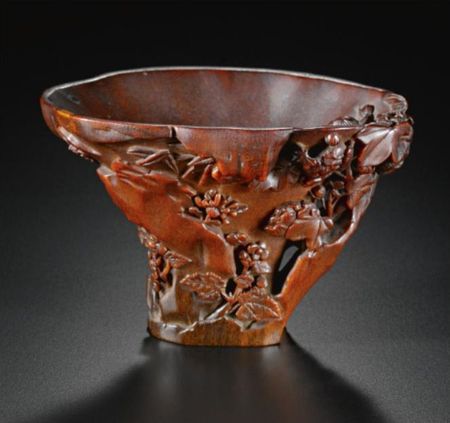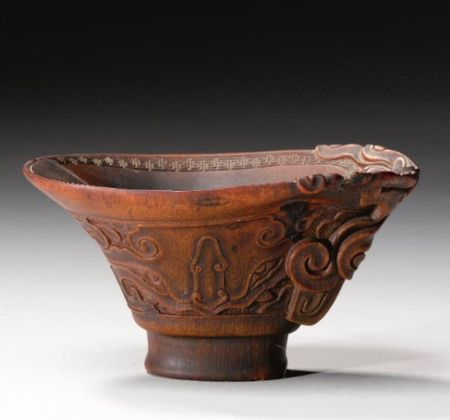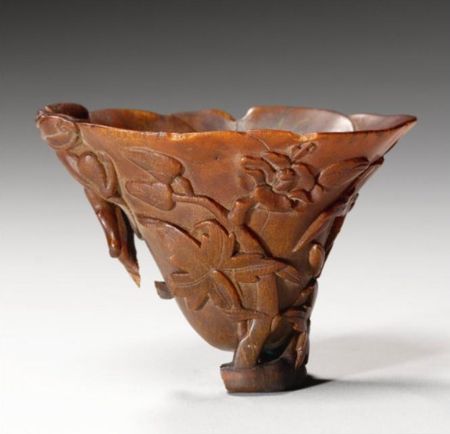Rhinoceros Horn Libation Cups @ Sotheby's, NY
A Magnificent Rhinoceros Horn Libation Cup With Hawks, Signed You Kan. Qing Dynasty, 17th-18th Century. Photo Sotheby's
the tall horn superbly carved in high relief as a pair of hawks by a gnarled tree with branches growing from the sides of a mountain ledge, several entwined branches forming the handle, and a few leafy twigs extending over the rim, one hawk perched on a small branch that extends round the side, the other in flight with legs drawn up and wings outstretched, the feathers finely incised, inscribed with a five-character inscription reading fang Xuanhe biyi, followed by an oval seal reading Zhi Sheng and a square seal reading You Kan, the material of a honey tone darkening towards the tip and with an extremely smooth patina, fitted wood stand (2); Height 5 1/4 in., 13.3 cm; Length 5 1/2 in., 14 cm; Depth 3 3/8 in., 8.6 cm. Estimate 300,000-500,000 USD
Property From A Private New England Collection
NOTE: The inscription on the present cup may be translated as 'in the style of Xuanhe', and is a reference to the paintings of the Song dynasty emperor Huizong, whose reign title was Xuanhe, and reveals the stylistic influence on the carver's work. The primary subjects of Xuanhe's paintings were birds and flowers, with the one titled Yu ying tu, Taming the Eagle, well known for its depiction of a single bold white-feathered eagle perched on a wooden pole. The two eagles on the present vessel are similarly strong and majestic. They dominate the design with power and supremacy. Theon the present vessel are similarly strong and majestic. They dominate the design with power and supremacy. The bareness of the tree further enhances the prominence of the main subject matter – the overall composition is creative with an effective use of space. This type of composition is recognizably in the tradition of Xuanhe whose work the carver must have admired and tried to emulate.
Birds of prey such as eagles, ying, in Chinese design represent the hero, yingxiong, as its name is homophonous with the character for hero. Furthermore, a flying eagle conveys the message for attaining a journey of ten thousand miles which is a wish for a long and successful career.
The present rhinoceros horn cup, which bears the name of the 17th century master carver You Kan, is striking for its unusual subject matter and bold manner of carving.
You Kan's works are well known and documented - there are more pieces bearing his name than the name of any other rhinoceros horn carver. Amongst these pieces, those depicting eagles are rare and no other similar work by You Kan appears to be recorded. There is a possibility that the seals bearing You Kan's name were added later to the present lot as an homage to this great master carver.
According to Jan Chapman, You Kan was a palace carver active during the period circa 1650-1720. He was extremely versatile with his designs and his technique is described as careful and conscientious with an emphasis on realism especially when depicting flowers and animals. The sophistication of his work is expressed in the skillful use of the material and in the spacing of the design which frequently takes advantage of the organic form and fibrous inclusions of the material. See Jan Chapman, The Art of Rhinoceros Horn Carving in China, London, 1999, p. 139.
Three rhinoceros horn cups bearing You Kan's signature can be found carved with images of chicken. One in the Palace Museum, Beijing, illustrated ibid., pl. 250, formerly in the collection of Dr. Ip Yee; one sold at Christie's Hong Kong, 1st November 2004, lot 951; and the third cup sold in these rooms, 19th March 2007, lot 373.
An unsigned cup depicting two hawks strategically placed to take advantage of the material's organic form, one bird standing on a pine branch while the second depicted in flight with wings outstretched and feet drawn towards the body is possibly the closest related example recorded to the present piece. This cup, described by its former owner, Edward T. Chow, as 'only the hand of a renowned master could have made this extremely forceful yet fine carving', was sold in our Hong Kong rooms, 8th April 2011, lot 2718.
A Fine And Rare Rhinoceros Horn 'Flowers' Libation Cup. Qing Dynasty, Kangxi Period. Photo Sotheby's
well carved and undercut in high relief with a profusion of flowers amidst rockwork, a large peony shrub forming the handle with a large blossom trailing over the rim, with cockscomb, begonia and chrysanthemum sprouting from craggy rocks and bamboo entwined with pomegranate on the hill ledges above, the horn of deep reddish brown and very smooth patina. Length 5 3/4 in., 14.6 cm. Estimate 120,000-150,000 USD
Property From A New York Collection
NOTE: This present lot is a fine example of a group of horn cups carved with an extravagant design of mixed flowers expressing a wealth of good wishes. The peony is dominant and emblematic of prosperity, the chrysanthemum, in combination with the bamboo, conveys the wish for longevity and nobility. The bamboo and chrysanthemum also symbolize fortitude and simplicity, qualities every gentleman should have. The cockscomb promises promotion and success, and the begonia represents posterity.
A cup from the collection of Michael de Salys Longchamps is illustrated by Thomas Fok, Connoisseurship of Rhinoceros Horn Carving, Hong Kong, 1999, no. 89; and another with the same theme as the present lot, but including butterflies which represent romantic happiness and longevity, from the Qing Court Collection is illustrated in The Complete Collection of Treasures of the Palace Museum: Bamboo, Wood, Ivory, Rhinoceros Horn Carvings, Hong Kong, 2002, no. 129.
A Fine Archaistic Rhinoceros Horn Libation Cup. Qing Dynasty, Kangxi Period. Photo Sotheby's
the vessel of typical truncated tapering form, well carved in low-relief around the sides with a central band enclosing confronting kui dragons on a leiwen ground, with a 'T'-scroll border encircling the inner and outer edges of the broad rectangular rim, interrupted by the spout with two chilong carved in high relief skimming the surface, set opposite the handle with two further chilong clambering up the vessel, one gaining the top and peering over the edge, the smoothly finished horn a dark reddish brown color; Length 6 in.,15.2 cm. Estimate 80,000-120,000 USD
Property From A New York Collection
An Archaistic Rhinoceros Horn Libation Cup. Qing Dynasty, 17th Century. Photo Sotheby's
finely carved around the sides in low relief with a central band of taotie masks and numerous chilong clambering around the sides in high relief, the largest entwined with the handle and peering over the rim, all supported on four splayed mask feet with a writhing chilong on the base, the horn of a rich, dark-honey tone; Length 6 1/2 in., 16.5 cm. Estimate 40,000-60,000 USD
A Lotus Leaf-Form Rhinoceros Horn Libation Cup. Qing Dynasty, 18th Century. Photo Sotheby's
naturalistically carved as a ribbon-tied bunch of flowers, a large veined lotus leaf furled to form the cup, its stem forming the handle with a sprig of millet, water fronds, lotus blossoms, a dragonfly and a cricket encircling the insect nibbled sides, a small crab biting a spray of grain and three small snails on the interior, the horn stained a dark chocolate brown, inscribed yong bao under the handle; Width 6 in., 15.2 cm. Estimate 30,000-50,000 USD
Property From An American Family Collection
NOTE: This present lot is filled with symbolism. In Chinese, the lotus is called lian, which is a pun on the word for 'year', and a homophone for the word 'continuous'. This idea of yearly continuity, is further reinforced by the millet stalk which is called sui in Chinese, the sound of which is similar to the word for 'age' and is another way of saying 'year'. Crab in Chinese in called xie, which sounds like the word 'harmony', and the grain clutched by the crab is called he, a homophone for another word also meaning harmony. The crab and the grain therefore form the rebus hexie, a common compound word for conjugal harmony, and together with the lotus, form the larger rebus lian nian hexie, continual harmony year after year.
The two characters yong bao found under the handle literally mean 'to be treasured forever' and there is a possibility that it could be the name of the artist, although no artist by that name appears to be recorded.
A Rhinoceros Horn Libation Cup. Qing Dynasty, 17th-18th Century. Photo Sotheby's
the vessel naturalistically carved in the form of a flowering prunus tree, the truncated base undercut as a gnarled tree trunk, with overhanging branches and blossoms forming the handle and extending over the rim, the horn a warm honey-brown color, Width 5 1/2 in., 14 cm. Estimate 10,000-15,000 USD
Property From An American Family Collection
An Archaistic Rhinoceros Horn Libation Cup. Qing Dynasty, 17th-18th Century. Photo Sotheby's
the bowl of wide flaring and gently tapering form, carved around the body with a wide band of taotie masks in linear relief on a leiwen ground, the inside rim with a key-fret border, the bifurcated body and tail of a dragon forming a handle, its head and claws reaching over the rim on one side of the cup, the horn a dark-brown tone; Width 5 1/2 in., 14 cm. Estimate 12,000-15,000 USD
Property From An American Family Collection
A Flower-form Rhinoceros Horn Libation Cup. Qing Dynasty, 17th-18th Century. Photo Sotheby's
carved as a mallow blossom, supported on a stem issuing from a branch intertwined with further stems rising to the rim, with small buds, serrated leaves and blossoming flowerheads, the handle in the form of a branch with a clambering chilong peering over the rim, the horn of amber-brown tone. Width 4 1/2 in., 11.4 cm. Estimate 7,000-9,000 USD
Property From An American Family Collection
Sotheby's. Fine Chinese Ceramics & Works of Art. New York. 14 september 2011 www.sothebys.com

/https%3A%2F%2Fprofilepics.canalblog.com%2Fprofilepics%2F1%2F0%2F100183.jpg)
/https%3A%2F%2Fstorage.canalblog.com%2F03%2F02%2F119589%2F96711876_o.jpg)
/https%3A%2F%2Fstorage.canalblog.com%2F11%2F31%2F119589%2F94773502_o.jpg)
/https%3A%2F%2Fstorage.canalblog.com%2F20%2F83%2F119589%2F94772815_o.jpg)
/https%3A%2F%2Fstorage.canalblog.com%2F26%2F72%2F119589%2F75604929_o.jpg)
/https%3A%2F%2Fstorage.canalblog.com%2F59%2F60%2F119589%2F26458628_o.jpg)










/image%2F1371349%2F20240229%2Fob_bcf2a6_429481554-1625272224909457-79208462982.jpg)
/http%3A%2F%2Fstorage.canalblog.com%2F51%2F60%2F119589%2F126452602_o.jpg)
/http%3A%2F%2Fstorage.canalblog.com%2F35%2F48%2F119589%2F126270429_o.jpg)
/http%3A%2F%2Fstorage.canalblog.com%2F27%2F14%2F119589%2F126269685_o.jpg)